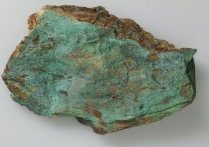Where does this mineral wealth comes from?
Other ores result from either mid ocean ridge volcanic activity in the Alpine Ocean, or from the volcanic activity of an old Palaeozoic mountain range. Other minerals like quartz are often associated to the emplacement of granitic rocks.
Pierre ollaire, or soapstone, is linked to the transformation of peridotite from the Earth's mantle. Raised to the Earth's surface during the opening of the Alpine Ocean, or rifting, these peridotites were initially transformed into serpentinites by hydrothermal transformation on the mid-ocean ridge, and subsequently by Alpine burial. These transformations produce pierre ollaire, but also talc and asbestos.
Mid-ocean ridge volcanic activity is also responsible for the quantity of metal polysulfides rich in copper in the form of chalcopyrite, zinc as sphalerite, lead as galena, and sometimes assocoiated with manganese. Chalcopyrite and manganese are associated to Alpine Ocean rock, and familiar in the Upper Val d’Hérens.
NB: Rock crystal, or quartz, develops from silica-rich fluid circulations associated with granitic magma.
Subduction zones, which deeply bury ocean floor rocks, release liquids rich in metal under the upper plate. In the Andes cordillera metallic deposits are located with regard to the distance of the subduction trench (over a zone of a few hundreds of km). Iron is the metal closest to the trench, followed by gold, lead, zinc, silver and tin furthest from the trench. These metals are often associated to magmatic and volcanic rocks. The presence of copper and lead in Val d’Hérens basement rocks (lien vers chapitre 8) reveals their origin to be centred in a Lower Palaeozoic cordillera.
Besides volcanic and magmatic activity, metamorphism in general is linked to many types of mineralisation resulting from liquid and gas displacements in the Earth’s crust. These liquids become enriched with minerals whilst rising to the surface and, together with other elements like silica and calcite, are deposited in fractures or porous rocks along the way. Seams or veins can develop and are often rich in metals like gold. The Série Grise for example represents Alpine Ocean floor sediments from the accretionary prism in front of the African plate, is rich in white quartz and calcite veins, deformed into nodules.
Other alpine minerals such as jadeite and garnet are linked with high pressure metamorphism, that is, burial of 60 or more kilometres deep. These were used to make extra-resistant polished axes in the 5th and 4th millennium BC and exported all over Europe. Found in rocks called eclogites, highly dense, 3.3, and although absent in the Val d’Hérens, are present in the Zermatt region and in Italy.
















